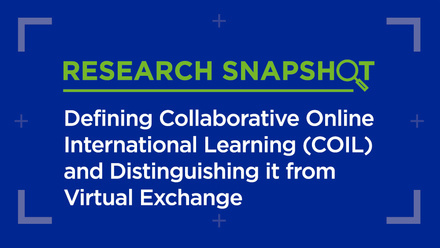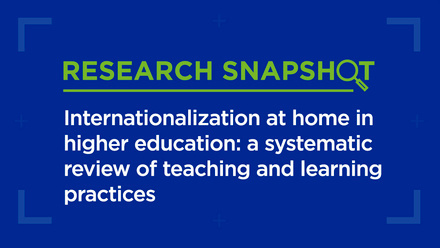6 ingredients for online international classrooms

After this extraordinary year of COVID-19 lockdowns, which resulted in the rapid transition to online learning and suspended international student mobility, it is time to look back and reflect on some important lessons we can take away regarding Collaborative Online International Learning (COIL) and the international online classroom.
The necessity to move our classes online made educators explore and experiment actively with new tools, pedagogies and collaborative formats. At the same time, the boundaries of the classroom, the campus and traditional categories like ‘at home’ and ‘abroad’, ‘domestic students’ and ‘international students’ have become more fluid. Internationalisation has rapidly come within every lecturer’s reach as classrooms the world over can now be connected. In this blog post, four experts in the field of international education provide six key ingredients for enhancing international online teaching and learning beyond the pandemic.
1. Connecting our classrooms and opening up opportunities for international collaboration
Online classrooms are no longer confined to the institutional, local and national borders, and have thus become more open and accessible. Students and lecturers can participate in online education from anywhere in the world. It is also much easier to connect with lecturers and students abroad via online platforms. This provides us with opportunities for more international co-teaching, inviting guest speakers, bringing in diverse perspectives and connecting our (online) classrooms with other classrooms globally.
2. Making use of the diverse student body
Since it has become much easier to bring students together for a period of time, it is now possible to intentionally create diverse classes, groups, or teams to facilitate a (temporary) multi-perspective learning environment. We can use the diversity of our student body as a resource for bringing cultural, local or disciplinary perspectives, knowledge and first-hand experiences into our online classrooms.
3. Cross-cultural online learning by instructional design
Although it might be easier to create diverse groups online, it is just as hard to make students mix, share and collaborate in an online space. Hence, it is essential to intentionally design courses that put an emphasis on cross-cultural interaction and collaboration. Carefully consider the outcomes you would like to achieve and the sort of interaction this requires. A well-designed collaborative online learning assignment requires a relationship of mutual dependence where both student groups have equal status, for instance each group has specific knowledge or skills that are required for the successful completion of the task and/or students take on different roles within the task and rely on each other to complete the task.
It is essential to intentionally design courses that put an emphasis on cross-cultural interaction and collaboration
4. Use your synchronous time intentionally
Online education is a different pedagogy to face-to-face education and requires a complete re-think of how lessons are designed and what students do in synchronous Teams or Zoom sessions and what activities are better suited in synchronous and asynchronous (out-of-class) format. Many blended learning models and collaborative online learning approaches use a combination of synchronous interaction and dialogue and asynchronous input. Carefully consider how you design your online sessions as quality time that fuels, deepens or supports your students’ asynchronous learning.
5. Take time for reflection on online intercultural learning
Just as in the physical classroom, or an experience abroad, merely being exposed to different cultural perspectives does not automatically lead to intercultural learning, and this also applies to the online sphere. It is important to incorporate opportunities to zoom out, reflect and make sense of the online intercultural encounters as a source of transformative intercultural learning that is able to expand our students’ horizon without (necessarily) leaving their home. Providing our students with reflection models, helps them make sense of the experience and transfer their newly-acquired skills in other contexts.
6. Creating a safe, inclusive, accessible online learning environment
Online platforms are quite a daunting place, especially when we meet people online for the first time. We miss social cues that we once had in a physical setting and communication can be awkward and sometimes misinterpreted. Therefore, creating a safe and inclusive learning environment is paramount and requires even more time and attention online. Cross-cultural interaction depends on students’ willingness to engage. The groundwork for this can be laid by devoting time to icebreakers, helping students to build a relationship with lecturers and with each other and by making ourselves approachable for students before and after class. In addition, issues surrounding privacy and accessibility need to be considered and addressed by higher education institutions with online education protocols. Ground rules must be set and monitored consistently to create a safe space for dialogue and exchange for both educators and students.
The boundaries of the classroom, the campus and traditional categories like ‘at home’ and ‘abroad’ have become more fluid
As overwhelming as this past year has been, the pandemic has catapulted higher education institutions into online teaching and collaboration. With a return to in-person teaching on the horizon, the advantages of connecting our classrooms with the world around us have demonstrated the possibilities for global learning, at home as well as online.






